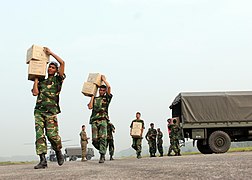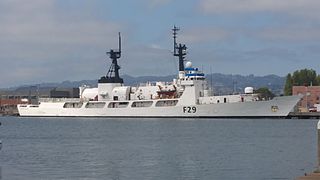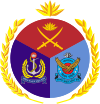Bangladesh Armed Forces
| Bangladesh Armed Forces | |
|---|---|
| বাংলাদেশ সশস্ত্র বাহিনী Bāṅlādēś Sôśôstrô Bāhinī | |
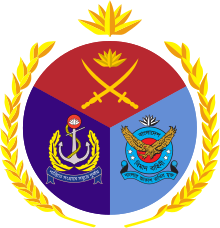 Crest of Bangladesh Armed Forces | |
 Flag of Bangladesh Armed Forces | |
| Motto | চির উন্নত মম শির (de facto) ("Ever High is My Head") |
| Founded | 21 November 1971 |
| Current form | 12 January 1972 |
| Service branches | |
| Headquarters | Armed Forces Division Headquarters, Dhaka Cantonment |
| Website | afd |
| Leadership | |
| Commander-in-Chief | |
| Minister of Defence | |
| Principal Staff Officer | |
| Personnel | |
| Military age | 18 years |
| Conscription | No[1] |
| Reaching military age annually | 3,176,505[2] |
| Active personnel | 204,000[3][4] |
| Deployed personnel | 10,736 for United Nations peacekeeping |
| Expenditure | |
| Budget | 6.995 billion USD (2024) |
| Percent of GDP | 1.5% (2024) |
| Industry | |
| Domestic suppliers | |
| Foreign suppliers | |
| Annual imports | US$754 million (2011–2020) |
| Related articles | |
| History | |
| Ranks | Military ranks of Bangladesh |

The Bangladesh Armed Forces (Bengali: বাংলাদেশ সশস্ত্র বাহিনী, romanized: Bāṅlādēś Sôśôstrô Bāhinī) are the military forces of the People's Republic of Bangladesh. They consist of the three uniformed military services: the Bangladesh Army, the Bangladesh Navy, and the Bangladesh Air Force. The Armed Forces are under the jurisdiction of the Ministry of Defence of the Government of Bangladesh, and are directly administered by the Armed Forces Division of the Prime Minister's Office.[5] The President of Bangladesh serves as the Commander-in-Chief of the Bangladesh Armed Forces. Bangladesh has the third-largest defence budget in South Asia. The Bangladeshi military is the 37th strongest in the world and the third most powerful military force in South Asia.[6] Border Guard Bangladesh and Bangladesh Coast Guard are under the jurisdiction of the Ministry of Home Affairs[7] during peacetime, but during wartime, they fall under the command of the Bangladesh Army and the Bangladesh Navy, respectively.
Military policy is formulated and executed by the Armed Forces Division (AFD), whereas the Ministry of Defence (MoD) does not exercise any operational or policy authority over the Armed Forces. Since independence, the AFD and MoD have been led by the Prime Minister. To coordinate military policy with foreign and intelligence policy, both the President and the Prime Minister are advised by a six-member advisory board, which consists of the three military services' Chiefs of Staff, the Principal Staff Officer of the Armed Forces Division, and military secretaries to the President and the Prime Minister. The directors-general of the NSI, the DGFI, and the BGB also serve in an advisory capacity when invited.[8][9]
Armed Forces Day is observed on 21 November and commemorates the founding of the three services of the Armed Forces, who subsequently initiated a joint military operation against the occupying Pakistani Armed Forces during the Bangladesh Liberation War.[10][11] Official functions are held across the country, including at Bangabhaban, the Armed Forces Division Headquarters at Dhaka Cantonment, all military cantonments, and at every military installation throughout Bangladesh.[12]
History
[edit]Eastern wing of Pakistan
[edit]With the partitioning of India on August 15, 1947, the territory constituting modern Bangladesh was partitioned from the province of Bengal as East Bengal, joining the newly created state of Pakistan. Ethnic and sectional discrimination prevailed in all sectors of the state. Like other government sectors, Bengalis were under-represented in the Pakistani military too. Officers of Bengali origin in the different wings of the armed forces made up just 5% of overall force by 1965.[13] West Pakistanis believed that Bengalis were not "martially inclined" unlike Pashtuns and Punjabis; the "Martial Races" notion was dismissed as ridiculous and humiliating by Bengalis.[13] Moreover, despite huge defence spending, East Pakistan received none of the benefits, such as contracts, purchasing and military support jobs. The Indo-Pakistani War of 1965 over Kashmir also highlighted the sense of military insecurity among Bengalis as only an under-strength infantry division and 15 combat aircraft without tank support were in East Pakistan to repel any Indian retaliations during the conflict.[14][15]
The East Bengal Regiment was formed on 15 February 1948 following Pakistan's independence and transition from post British rule, composed exclusively of men from the western part of the country. The first East Bengal Regiment was composed of Bengali members of the British Indian Army Pioneer Corps and Bihar Regiment of the abolished British-Indian army. Between 1948 and 1965, a total of eight battalions of EBR were raised.[16][17]
Bangladesh Liberation War
[edit]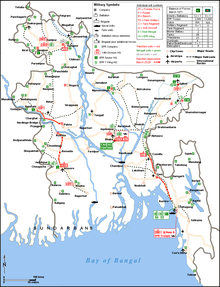

Following the victory of the Awami League in the 1970 elections, then-president General Yahya Khan refused to appoint its leader Sheikh Mujibur Rahman as the prime minister and launched a brutal attack named Operation Searchlight on the civilians of the then East Pakistan, using the Pakistan Army to repress political movements.[18] The number of people killed by Pakistani forces vary from a minimum of around 300,000 to a maximum of around 3 million.[19][20] Responding to Mujib's call for rebellion, many students, workers and other civilians mutinied against Pakistan and raised the Mukti Bahini, a guerrilla force. Later on, many Bengali officers and units from the Pakistan Army and East Pakistan Rifles mutinied against their West Pakistani counterparts and joined the Mukti Bahini.[21][22][23] On 17 April 1971, M. A. G Osmani took oath as the commander-in-chief of Mukti Bahini. While the war raged on, the necessity of a well-trained armed force was always felt. During the first Bangladesh Sector Commanders Conference, held from 11 to 17 July 1971, the Bangladesh Forces started its journey composed of the revolting Bengali members of the Pakistan Army and EPR.[24] In this historic conference the field command structure, sector reorganization, reinforcement, appointment of field commanders and tactics of warfare were decided upon and carried out. On 21 November 1971, the Bangladesh Forces was divided into three separate services as Bangladesh Army, Bangladesh Navy and Bangladesh Air Force.
The Bangladesh Forces received modest assistance from the Indian Government soon after the start of the war.[25] On 3 December 1971, the India-Pakistan war broke out and Indian troops entered Bangladesh allied with the Bangladesh Armed Forces.[26] On 16 December 1971, the Pakistani military surrendered to the joint Indian and Bangladesh forces.[27]
Post-independence
[edit]The newly formed Bangladeshi armed forces incorporated some of the units and guerrillas of the Mukti Bahini.[28] Gen. Osmani, who had led the Mukti Bahini was appointed the General of the Bangladesh armed forces.[29] For many years, there was active discrimination in favour of the inductees from the Mukti Bahini against those Bengali officers who had continued service in the Pakistani armed forces or had been detained in West Pakistan.[28][30] A group of angered officers assassinated the president Sheikh Mujib on 15 August 1975 and established a regime with politician Khondaker Mostaq Ahmed as President of Bangladesh and new army chief Maj. Gen. Ziaur Rahman.[30] The military itself was subject of divisions as Mujib's assassins were overthrown by the pro-Mujib Brig. Gen. Khaled Mosharraf on 3 November, who himself was soon overthrown by a socialist group of officers under Col. Abu Taher on 7 November who returned Ziaur Rahman to power—an event now called the Sipoy-Janata Biplob (Soldiers and People's Coup).[31] Under the presidency of Ziaur Rahman, the military was reorganised to remove conflicts between rival factions and discontented cadre.[32] However, Ziaur Rahman was himself overthrown in a 1981 coup attempt,[33] and a year later, Lt. Gen. Hossain Mohammad Ershad took power from the elected government of president Abdus Sattar. The military remained the most important force in national politics under the regimes of Ziaur Rahman and later Hossain Mohammad Ershad until democracy was restored in 1991.[32]
Modern period
[edit]
Having relied primarily on India and the Soviet Union for military aid, Bangladesh has also developed military ties with the People's Republic of China and the United States. The Bangladesh Army has been actively involved in United Nations Peace Support Operations (UNPSO). During the first Gulf War in 1991, the Bangladesh Army sent a 2,193 member team to monitor peace in Saudi Arabia and Kuwait. The Bangladesh Army also participated in peace keeping activities in Namibia, Cambodia, Somalia, Uganda, Rwanda, Mozambique, former Yugoslavia, Liberia, Haiti, Tajikistan, Western Sahara, Sierra Leone, Kosovo, Georgia, East Timor, Congo, Côte d'Ivoire and Ethiopia. As of October 2008, Bangladesh remained the second largest contributor with 9,800 troops in the UN Peacekeeping forces.
Until a peace accord was signed in 1997, the Bangladeshi military engaged in counterinsurgency operations in the Chittagong Hill Tracts fighting the Shanti Bahini separatist group. In 2001, Bangladeshi military units engaged in clashes with the Indian Border Security Force (BSF) along the northern border.[34]
Several projects and schemes aiming to expand and modernize the Bangladeshi armed forces were launched by the government of former Prime Minister Begum Khaleda Zia.
Forces Goal 2030 was launched by the government of Prime Minister Sheikh Hasina to secure new equipment for the Bangladeshi military.
Bangladesh-Myanmar border
[edit]Standoffs have occasionally occurred at the Bangladesh-Myanmar border, including in 1991 and 2008. Most of the standoffs took place, when Myanmar attempted to force Rohingyas into Bangladesh. In 2008, the two countries deployed warships after Myanmar attempted to explore a disputed Bay of Bengal seabed for oil and gas. The dispute was resolved at an international tribunal in 2012. Bangladesh and Myanmar have also conducted counter-insurgency operations on the border.
Medals and decorations
[edit]The following are the various gallantry, service and war medals of the Bangladesh Armed Forces.[35][self-published source?][36][self-published source?][37][self-published source?][38][39][self-published source?]
Gallantry awards
[edit] Bir Sreshtho-(Bengali: বীরশ্রেষ্ঠ; literally, "The Most Valiant Hero"), the highest gallantry award
Bir Sreshtho-(Bengali: বীরশ্রেষ্ঠ; literally, "The Most Valiant Hero"), the highest gallantry award Bir Uttom- (Bengali: বীর উত্তম; literally, "Better among Braves"), the second highest gallantry award
Bir Uttom- (Bengali: বীর উত্তম; literally, "Better among Braves"), the second highest gallantry award Bir Bikrom- (Bengali: বীর বিক্রম; literally, "Valiant hero"), the third highest gallantry award
Bir Bikrom- (Bengali: বীর বিক্রম; literally, "Valiant hero"), the third highest gallantry award Bir Protik- (Bengali: বীর প্রতীক; literally, "Symbol of Bravery or Idol of Courage"), the fourth highest gallantry award
Bir Protik- (Bengali: বীর প্রতীক; literally, "Symbol of Bravery or Idol of Courage"), the fourth highest gallantry award
Service medals
[edit] Order of Military Merit
Order of Military Merit Jestha Padak I (10 years service)
Jestha Padak I (10 years service) Jestha Padak II (20 years service)
Jestha Padak II (20 years service) Jestha Padak III (30 years service)
Jestha Padak III (30 years service)
Current deployments
[edit]
Bangladesh has consistently made large contributions to United Nations peacekeeping operations. As of May 2007, Bangladesh had major deployments in Democratic Republic of Congo, Liberia, Lebanon, Sudan, Timor-Leste and Côte d'Ivoire.[40] With 10,736 troops deployed, it ranks first in personnel contributions to UN peacekeeping.[41] The government declined to participate in Iraq on a request from the United States. The deployment to Liberia began in October 2003 and has remained at a level of about 3,200 who are participating in peacekeeping, charitable activities and infrastructure development.
Training
[edit]Officers are trained and educated for three years at the Bangladesh Military Academy, Bhatiary, Bangladesh Naval Academy at Patenga, both located in Chittagong and Bangladesh Air Force Academy located in Jessore. For advance training during their career, officers are sent to Bangladesh Defence Services Command and Staff College at Mirpur, while senior officers attend the National Defense University for Armed Forces War Course. Many attend the Military Institute of Science and Technology while serving. Officers of the Army Medical Corps are recruited after graduation from both military or civil medical colleges. They undergo basic military training at Bangladesh Military Academy followed by professional training in medical corps centre and Armed Forces Medical Institute. Recently cadets of Armed Forces Medical College also started joining the services directly.[42]
Ranks
[edit]Bangladeshi military ranks, essentially corresponds to those used by the armed forces of the commonwealth nations.
The rank insignia for commissioned officers for the Armed forces respectively.
| Rank group | General / flag officers | Senior officers | Junior officers | |||||||||||||||||||||
|---|---|---|---|---|---|---|---|---|---|---|---|---|---|---|---|---|---|---|---|---|---|---|---|---|

|

|

|

|

|

|

|

|

|

| |||||||||||||||
| জেনারেল Jēnārēl |
লেফটেন্যান্ট জেনারেল Lēphṭēnānṭ jēnārēl |
মেজর জেনারেল Mējar jēnārēl |
ব্রিগেডিয়ার জেনারেল Brigēḍiẏār jēnārēl |
কর্নেল Karnēl |
লেফটেন্যান্ট কর্নেল Lēphṭēnānṭ karnēl |
মেজর Mējar |
ক্যাপ্টেন Kaepṭēn |
লেফটেন্যান্ট Lēphṭēnānṭ |
সেকেন্ড লেফটেন্যান্ট Sēkēnḍ lēphṭēnānṭ | |||||||||||||||
 
|
 
|
 
|

|

|

|

|

|

|

|

| ||||||||||||||
| এ্যাডমিরাল Aeḍmirāl |
ভাইস এ্যাডমিরাল Bhā'is aeḍamirāl |
রিয়ার এ্যাডমিরাল Riẏār aeḍamirāl |
কমোডোর Kômōḍōr |
ক্যাপ্টেন Kaepṭēn |
কমান্ডার Kômānḍār |
লেফটেন্যান্ট কমান্ডার Lēphṭēnānṭ kômānḍār |
লেফটেন্যান্ট Lēphṭēnānṭ |
সাব-লেফটেন্যান্ট Sāb-lēphṭēnānṭ |
এ্যাক্টিং সাব-লেফটেন্যান্ট Ēyākṭiṁ sāb-lēphṭēn'yānṭ |
মিডশিপম্যান Miḍśipmaen | ||||||||||||||

|

|

|

|

|

|

|

|

|

| |||||||||||||||
| এয়ার চিফ মার্শাল Ēẏār chiph mārśāl |
এয়ার মার্শাল Ēẏār mārśāl |
এয়ার ভাইস মার্শাল Ēẏār bhā'is mārśāl |
এয়ার কমোডোর Ēẏār kômōḍōr |
গ্রুপ ক্যাপ্টেন Grup kaepṭēn |
উইং কমান্ডার U'iṁ kômānḍār |
স্কোয়াড্রন লীডার Skōẏāḍran līḍār |
ফ্লাইট লেফটেন্যান্ট Phlā'iṭ lēphṭēnānṭ |
ফ্লাইং অফিসার Phlā'iṁ ôphisār |
পাইলট অফিসার Pā'ilôṭ Ôphisār | |||||||||||||||
| Rank group | General / flag officers | Senior officers | Junior officers | |||||||||||||||||||||
Organization
[edit]Regular forces
[edit]- Bangladesh Army (Bangladesh Sena Bahini)
- Bangladesh Navy (Bangladesh Nou-bahini)
- Bangladesh Air Force (Bangladesh Biman Bahini)
Para-military forces
[edit]- Border Guard Bangladesh (BGB)
- Bangladesh Coast Guard (BCG)
Civil forces and reserves
[edit]- Bangladesh Ansar
- Village Defence Party (VDP)
- Bangladesh National Cadet Corps (BNCC)
- Bangladesh Police
Specialized forces
[edit]- President Guard Regiment (PGR) – Bangabhaban (President's Office)
- Special Security Force (SSF) – Prime Minister's Office
- Para-Commando Brigade (The Cheetahs) – Under Command AHQ, Dhaka, Bangladesh Army
- Special Warfare Diving And Salvage (SWADS) – Bangladesh Navy
- 41 Squadron Airborne - Special Ground Combatants (SGC) – Bangladesh Air Force
- Rapid Action Battalion ("RAB") – Bangladesh Police
- Counter Terrorism and Transnational Crime ("CTTC") – Bangladesh Police
Military districts
[edit]- Savar Area Command
- Ghatail Area Command,Tangail
- Bogra Area Command
- Rangpur Area Command
- Comilla Area Command
- Chittagong Area Command
- Ramu Area Command
- Jessore Area Command
- Sylhet Area Command
- Barisal Area Command
- Army Training and Doctrine Command
- Army Logistics Area
- HQ All Military Lands
- HQ Cantonment Boards
- HQ's of Bangladesh Army
- Armed Forces Division (AFD)
- 46 Independent Infantry Brigade
- 24 Independent Engineers Brigade
- 18 Engineers Brigade
- 6 Air Defence Brigade
- 14 Army Signal Brigade
- HQ, President's Guard Regiment
- Inter Services Selection Board (ISSB)
- HQ's Armed Forces Medical and Nursing Corps (AFMNC)
- Central Officer's Record Office (CORO)
- HQ's Armed Forces Recruiting Centre (AFRC)
- HQ's Cantonment Public Schools
- HQ's Armed Forces Library
- Armed Forces Institute of Pathology (AFIP)
- National Armed Forces Cemetery
Educational and training institutes
[edit]- Army Institute of Business Administration (Army IBA), Savar Cantonment, Dhaka
- Bangladesh Military Academy (BMA), Bhatiari, Chittagong
- Bangladesh Army International University of Science & Technology (BAIUST), Cumilla Cantonment.
- School of Infantry and Tactics (SI&T), Jalalabad Cantonment, Sylhet.
- Defence Services Command and Staff College (DSC&SC), Mirpur Cantonment, Dhaka.
- National Defence College (NDC), Mirpur Cantonment, Dhaka.
- Military Institute of Science and Technology (MIST), Mirpur Cantonment, Dhaka.
- Armoured Corps Centre & School (ACC&S), Majira Cantonment, Bogra.[46]
- Engineer Centre and School of Military Engineering, Qadirabad Cantonment, Natore.
- Signal Training Centre and School, Jessore Cantonment, Jessore.
- Army Service Corp Centre & School, Jahanabad Cantonment, Khulna.
- Army Medical Corps Centre & School, Shaheed Salahuddin Cantonment, Ghatail, Tangail.
- Ordnance Corps Centre & School, Rajendrapur Cantonment, Gazipur
- Bangladesh Institute of Peace Support Operation Training (BIPSOT), Rajendrapur Cantonment, Gazipur.
- Electrical and Mechanical Engineering Centre and School, Saidpur Cantonment, Nilphamari.
- Corps of Military Police Centre and School, Savar Cantonment, Savar, Dhaka.
- Army School of Education and Administration, Shahid Salahuddin Cantonment, Ghatail, Tangail.
- Army School of Physical Training and Sports (ASPTS), Dhaka Cantonment, Dhaka.
- Army School of Music, Chittagong Cantonment, Chittagong.
- Armed Forces Medical College (AFMC), Dhaka Cantonment, Dhaka.
- Army Medical College Chattogram (AMCC)
- Army Medical College Comilla (AMCCo)
- Army Medical College Bogra (AMCB)
- Army Medical College Jashore (AMCJ)
- Rangpur Army Medical College (RAMC)
Artillery Centre and School, Halishahar, Chittagong.
- School of Military Intelligence, Moynamoti Cantonment, Comilla.
- East Bengal Regimental Centre, Chittagong Cantonment, Chittagong.
- Bangladesh Infantry Regimental Centre, Rajshahi Cantonment, Rajshahi.
- Non Commissioned Officers Academy, Majira Cantonment, Bogra.[47]
- Bangladesh University Of Professionals(BUP), Mirpur Cantonment, Dhaka.
Training institutes of Bangladesh Air Force
[edit]- Bangabandhu Sheikh Mujibur Rahman Aviation and Aerospace University[48]
- Bangladesh Air Force Academy (BAFA), Jessore.
- Flying Instructors School (FIS), Bogra.
- Command and Staff Training Institute (CSTI), Dhaka.
- Flight Safety Institute (FSI), Dhaka.
- Officers' Training School (OTS), Jessore.
- Aero-Medical Institute (AMI), Dhaka.
- Fighter Controller Training Unit (FCTU), Dhaka.
- School of Physical Fitness (SOPF), Dhaka.
- Recruits Training School (RTS), Shamshernagar, Moulovibazar.
- Training Wing (TW), Chittagong.
- Mechanical Transport Driving School (MTDS), Shamsher Nagar.
- Helicopter Simulator Institute BAF(HSI), Dhaka
Training Institutes of Bangladesh Navy
[edit]- Bangladesh Naval Academy (BNA), Chittagong.
- BNS Shaheed Moazzem, Kaptai, Rangamati Hill District, Chittagong. (For Sailor's Advanced Training)
- BNS ISA KHAN, Chittagong (Home of 13 Different Training Schools)
- BNS TITUMIR, Khulna (Home of New Entry Training School (NETS) and School of Logistics and Management (SOLAM))
- School of Maritime Warfare & Tactics, Chittagong Port.
Army Cantonments
[edit]Cantonments are where Bangladesh Army personnel work, train, and live.[49]
- Alikadam Cantonment (Bandarban)
- Bandarban Cantonment (Bandarban)
- Bangladesh Military Academy (Chittagong District)
- Bogra Cantonment (Bogra)
- Chittagong Cantonment (Chittagong)
- Comilla Cantonment (Comilla)
- Dhaka Cantonment (Dhaka)
- Dighinala Cantonment (Khagrachhari)
- Halishahar Cantonment (Chittagong)
- Jahanabad Cantonment (Khulna)
- Jahangirabad Cantonment (Bogra)
- Jalalabad Cantonment (Sylhet)
- Jamuna Cantonment (Bhuapur, Tangail)
- Jessore Cantonment (Jessore)
- Kaptai Cantonment (Kaptai)
- Khagrachhari Cantonment (Khagrachhari)
- Kholahati Cantonment (Parbatipur, Dinajpur)
- Mirpur Cantonment (Mirpur)
- Mymensingh Cantonment (Mymensingh)
- Padma Cantonment (Munshiganj and Shariatpur)
- Postogola Cantonment (Dhaka)
- Qadirabad Cantonment (Natore)
- Rajendrapur Cantonment (Gazipur)
- Rajshahi Cantonment (Rajshahi)
- Ramu Cantonment (Ramu, Cox's Bazar)
- Rangamati Cantonment (Rangamati)
- Rangpur Cantonment (Rangpur)
- Saidpur Cantonment (Saidpur, nilphamary)
- Savar Cantonment (Savar)
- Shahid Salahuddin Cantonment (Ghatail, Tangail)
- Sheikh Hasina cantonment (Patuakhali)
Air Force bases
[edit]- BAF Base Bangabandhu (Dhaka)
- BAF Base Sheikh Hasina (Cox's Bazar)
- BAF Base Khademul Bashar (Dhaka)
- BAF Base Matiur Rahman (Jessore)
- BAF Base Paharkanchanpur (Tangail)
- BAF Base Zahurul Haq (Chittagong)
Navy bases
[edit]- BNS Haji Mohshin (Dhaka)[50]
- BNS Sheikh Mujib (Dhaka)
- BNS Issa Khan (Chittagong)
- BNS Shaheed Moazzem (Rangamati)
- BNS Sheikh Hasina (Cox's Bazar)
- BNS Sher-e-Bangla (Patuakhali)
- BNS Titumir (Khulna)
- BNS Ulka (Chittagong)
- BNS Bhatiary (Chittagong)
- BNS Nirvik (Chittagong)
- BNS Mongla (Bagerhat)
- BNS Patenga
- BNS Upasham
Future modernisation plans
[edit]Bangladesh has made a long term modernisation plan for its Armed Forces named Forces Goal 2030.[51] The plan includes the modernization and expansion of all equipment and infrastructures and providing enhanced training.[51]
Gallery
[edit]-
Humanitarian operation after Cyclone Sidr
-
Bangladesh Army soldiers unload a shipment of bottled water for cyclone victims.
-
Bangladesh Army personnel unloading boxes of food for cyclone victims at Barisal
-
Bangladesh Army personnel and armoured personnel carrier in UN peacekeeping mission
-
Army soldiers on active duty in Dhaka
-
Army personnel at Victory Day Parade 2012
-
Bangladesh Army's MBT-2000/VT-1A main battle tank at Victory Day Parade 2017
-
Bangladesh Army's Type-69 IIG main battle tank
-
AS365 Dauphin helicopter of Bangladesh Army Aviation Group
-
C-295 transport aircraft of Bangladesh Army
-
BTR-80 armoured personnel carrier of Bangladesh Army
-
Bangladesh navy frigate BNS Somudra Joy (F-28) at Pearl Harbor in 2013
-
BNS Bangabandhu (F-25) guided missile frigate at sea.
-
Bangladesh navy frigate BNS Somudra Avijan (F-29) at Alameda, California, in 2015
-
Bangladesh navy patrol ship BNS Sangu
-
Bangladesh Air Force Mikoyan MiG-29 multirole fighter aircraft
-
Chengdu F-7 BG fighter aircraft of Bangladesh Air Force
-
Lockheed Martin C-130J Super Hercules military transport aircraft of Bangladesh Air Force
-
Bangladesh Air Force Antonov An-32 (converted bomber)
-
Mil Mi-171Sh assault helicopter of Bangladesh Air Force
-
Bangladesh Air Force Mil Mi-17 helicopter at UN Peacekeeping mission
-
Bangladesh Air Force paratroopers descend from a C-130 aircraft
See also
[edit]- Government of Bangladesh
- Military coups in Bangladesh
- Forces Goal 2030
- Ministry of Defence (Bangladesh)
Notes
[edit]References
[edit]- ^ "South Asia :: Bangladesh — The World Factbook". un.org. CIA. Archived from the original on 30 July 2021. Retrieved 24 January 2021.
- ^ "Manpower Reaching Military Age Annually (2020)". Global Fire Power (GFP). Retrieved 19 June 2020.
- ^ প্রতিবেদক, নিজস্ব (8 June 2017). সশস্ত্রবাহিনীর মোট সদস্য সংখ্যা দুই লাখ চার হাজার ৫৯৬ জন [The total number of members of the armed forces is 2 lakh 4 thousand 596 people]. Bangladesh Pratidin (in Bengali). Retrieved 12 June 2024.
আইনমন্ত্রী আনিসুল হক বলেছেন, সশস্ত্র বাহিনীর মোট সদস্য সংখ্যা বর্তমানে দুই লাখ চার হাজার ৫৯৬ জন। এর মধ্যে ১ লাখ ৬২ হাজার ১২৫ জন সেনাবাহিনী। ২৫ হাজার ৮১ জন নৌবাহিনীর এবং ১৭ হাজার ৩৯০ জন বিমান বাহিনীর সদস্য।
[Law Minister Anisul Haque said that the total number of members of the armed forces is currently two lakh four thousand 596. Among them 1 lakh 62 thousand 125 soldiers. 25 thousand 81 members of Navy and 17 thousand 390 members of Air Force.] - ^ "সশস্ত্র বাহিনীর সদস্য সংখ্যা ২ লাখ ৪ হাজার ৫৯৬ জন". The Daily Sangram (in Bengali). 8 June 2017. Archived from the original on 30 December 2019. Retrieved 22 August 2024.
- ^ "About AFD". Armed Forces Division. Archived from the original on 30 August 2019. Retrieved 31 December 2021.
- ^ "Bangladesh ranks 37th in military power". Rising BD. 15 January 2024.
- ^ "Ministry of Home Affairs - Government of the People's Republic of Bangladesh". 16 December 1971. Archived from the original on 15 August 2023. Retrieved 21 May 2013.
- ^ "Hasina attends office at Armed Forces Division". The Daily Star (Bangladesh). 15 January 2009. Archived from the original on 3 October 2017. Retrieved 3 October 2017.
- ^ "Lt Gen Mahfuzur new principal staff officer of Armed Forces Division". The Daily Star (Bangladesh). 3 February 2016. Archived from the original on 11 August 2017. Retrieved 3 October 2017.
- ^ "Govt will continue efforts to modernise armed forces: PM". Bangladesh Sangbad Sangstha. 20 November 2002. Archived from the original on 28 September 2007.
- ^ "Armed Forces Day today". The Daily Star (Bangladesh). 21 November 2015. Archived from the original on 3 October 2017. Retrieved 3 October 2017.
- ^ "Significance of Armed Forces Day". The Daily Star (Bangladesh). 22 November 2009. Archived from the original on 3 October 2017. Retrieved 3 October 2017.
- ^ a b Heitzman, James; Worden, Robert, eds. (1989). "Pakistan Era". Bangladesh: A Country Study. Washington, D.C.: Federal Research Division, Library of Congress. p. 207. Archived from the original on 4 April 2023. Retrieved 23 March 2020.
- ^ "Demons of December — Road from East Pakistan to Bangladesh". Archived from the original on 9 June 2011. Retrieved 23 March 2020.
- ^ Jahan, Rounaq (1972). Pakistan: Failure in National Integration. Columbia University Press. pp. 166–167. ISBN 0-231-03625-6.
- ^ "Maj Abdul Gani". The Daily Star (Bangladesh). 11 November 2014. Archived from the original on 5 October 2016. Retrieved 6 October 2016.
- ^ "The 1965 War: A view from the east". Rediff.com. Archived from the original on 28 May 2017. Retrieved 13 December 2017.
- ^ Bose, Sarmila (8 October 2005). "Anatomy of Violence: Analysis of Civil War in East Pakistan in 1971". Economic and Political Weekly. Archived from the original on 1 March 2007.
- ^ Matthew White's Death Tolls for the Major Wars and Atrocities of the Twentieth Century Archived 9 June 2007 at the Wayback Machine
- ^ Virtual Bangladesh : History : The Bangali Genocide, 1971 Archived 23 July 2011 at the Wayback Machine
- ^ Heitzman, James; Worden, Robert, eds. (1989). "Zia's regime". Bangladesh: A Country Study. Washington, D.C.: Federal Research Division, Library of Congress. pp. 37–40. Archived from the original on 22 June 2011. Retrieved 23 March 2020.
- ^ Ahmed, Helal Uddin (2012). "Mukti Bahini". In Islam, Sirajul; Jamal, Ahmed A. (eds.). Banglapedia: National Encyclopedia of Bangladesh (Second ed.). Asiatic Society of Bangladesh. Archived from the original on 3 July 2015. Retrieved 23 March 2020.
- ^ Uddin, Syed Mohd. Saleh (2012). "Bangladesh Air Force". In Islam, Sirajul; Jamal, Ahmed A. (eds.). Banglapedia: National Encyclopedia of Bangladesh (Second ed.). Asiatic Society of Bangladesh. Archived from the original on 28 December 2020. Retrieved 23 March 2020.
- ^ "Bangladesh War of Independence". www.bengalrenaissance.com. Archived from the original on 26 December 2017. Retrieved 3 October 2017.
- ^ "Unfinished agenda of the Liberation War". The Daily Star (Bangladesh). 26 March 2016. Archived from the original on 3 October 2017. Retrieved 3 October 2017.
- ^ "The Tangail Landings: A signal for victory". The Daily Star (Bangladesh). 26 March 2015. Archived from the original on 4 October 2017. Retrieved 3 October 2017.
- ^ "Witnessing the surrender". The Daily Star (Bangladesh). 16 December 2012. Archived from the original on 4 October 2017. Retrieved 3 October 2017.
- ^ a b Heitzman, James; Worden, Robert, eds. (1989). "Postindependence Period". Bangladesh: A Country Study. Washington, D.C.: Federal Research Division, Library of Congress. p. 211. Archived from the original on 4 April 2023. Retrieved 23 March 2020.
- ^ Khan, Muazzam Hussain (2012). "Osmany, General Mohammad Ataul Ghani". In Islam, Sirajul; Jamal, Ahmed A. (eds.). Banglapedia: National Encyclopedia of Bangladesh (Second ed.). Asiatic Society of Bangladesh. Archived from the original on 17 June 2021. Retrieved 23 March 2020.
- ^ a b Heitzman, James; Worden, Robert, eds. (1989). "Mujib coup". Bangladesh: A Country Study. Washington, D.C.: Federal Research Division, Library of Congress. pp. 32–36. Archived from the original on 22 June 2011. Retrieved 23 March 2020.
- ^ Islam, Syed Serajul (May 1984). "The State in Bangladesh under Zia (1975–81)". Asian Survey. 24 (5). University of California Press: 556–573. doi:10.2307/2644413. JSTOR 2644413.
- ^ a b Heitzman, James; Worden, Robert, eds. (1989). "Restoration of Military Rule". Bangladesh: A Country Study. Washington, D.C.: Federal Research Division, Library of Congress. pp. 36–37. Archived from the original on 22 June 2011. Retrieved 23 March 2020.
- ^ "Bangladesh: Death at Night". Time. 8 June 1981. Archived from the original on 30 September 2007. Retrieved 10 September 2006.
- ^ "India-Bangladesh border conflict". BBC News. 18 April 2001. Archived from the original on 20 October 2014. Retrieved 23 March 2020.
- ^ "ODM of Bangladesh: Ribbon Chart". Medals of the World. Archived from the original on 4 March 2016. Retrieved 15 December 2015.
- ^ "Text List of Ribbons". Medals of the World. Archived from the original on 4 March 2016. Retrieved 15 December 2015.
- ^ "Orders, Decorations and Medals of Bangladesh". Jean-Paul LeBlanc. Archived from the original on 30 July 2014.
- ^ "Medals". Archived from the original on 1 July 2014. Retrieved 14 July 2014. Army Medal Lists: Official
- ^ "Asian Medals: Bangladesh". Militaria. Archived from the original on 22 December 2015. Retrieved 15 December 2015.
- ^ UN Mission's Summary detailed by Country Archived 27 March 2009 at the Wayback Machine, Monthly Summary of Contributors of Military and Civilian Police Personnel, Department of Peacekeeping Operations, United Nations, 31 May 2007
- ^ Ranking of Military and Police Contributions to UN Operations Archived 27 March 2009 at the Wayback Machine, Monthly Summary of Contributors of Military and Civilian Police Personnel, Department of Peacekeeping Operations, United Nations, 31 May 2007
- ^ "National Defence College". Bangladesharmy.org. Archived from the original on 29 September 2007. Retrieved 21 May 2013.
- ^ "Ranks & insignia". joinbangladesharmy.army.mil.bd. Retrieved 11 October 2020.
- ^ "Officer's Ranks". joinbangladeshairforce.mil.bd. Archived from the original on 19 February 2020. Retrieved 11 October 2020.
- ^ "Armoured Corps Center & School". www.army.mil.bd. Bangladesh Army. Archived from the original on 14 July 2014. Retrieved 14 July 2014.
- ^ Singh, Ravi Shekhar Narain (2005). Asian Strategic and Military Perspective. New Delhi: Lancer Publishers. p. 25. ISBN 817062245X.
- ^ "BSMR aviation and aerospace university bill passed". The Daily Star (Bangladesh). Archived from the original on 1 March 2019. Retrieved 1 March 2019.
- ^ "Cantonment Locations". www.joinbangladesharmy.mil.bd. Bangladesh Army. Archived from the original on 18 June 2015. Retrieved 14 July 2014.
- ^ "Bangladesh Navy Bases". Bangladesh Navy. Archived from the original on 27 May 2019.
- ^ a b "Forces Goal 2030 to be implemented in four phases: PM". New Age. 28 February 2013. Archived from the original on 15 March 2014. Retrieved 15 March 2014.
External links
[edit]- Official Website of Bangladesh Army Archived 31 December 2020 at the Wayback Machine
- Official Website of Bangladesh Air Force Archived 18 May 2010 at the Wayback Machine



